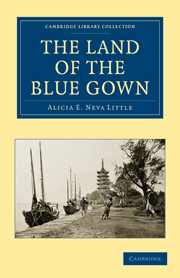Book contents
- Frontmatter
- PROLOGUE
- Contents
- LIST OF ILLUSTRATIONS
- CHAPTER I MY FIRST VISIT TO PEKING: BEFORE THE SIEGE
- CHAPTER II PILOT TOWN: TAKU
- CHAPTER III AUGUST TN CHEFOO
- CHAPTER IV ON THE WALLS OF SHANGHAI CITY
- CHAPTER V INSIDE SHANGHAI CITY
- CHAPTER VI INTO THE CHINESE COUNTRY
- CHAPTER VII APRIL NEAR NINGPO
- CHAPTER VIII SEPTEMBER IN WUHU
- CHAPTER IX THE DRAGON KING'S CAVERN AND DOME: ICHANG
- CHAPTER X FENGTU: THE CHINESE HADES
- CHAPTER XI CHEAP MISSIONARIES
- CHAPTER XII LIFE ON A FARMSTEAD: FIFTEEN HUNDRED MILES INSIDE CHINA
- CHAPTER XIII ANTI-FOREIGN RIOTS IN WESTERN CHINA
- CHAPTER XVI FURTHER ALARMS OF RIOTS
- CHAPTER XIV “BAD” WENTANG
- CHAPTER XVI LITTLE KNOWN BORDER TRIBES
- CHAPTER XVII TABLE DECORATIONS
- CHAPTER XVIII WHAT ARE MISSIONARIES DOING?
- CHAPTER XIX PART I.—AN ANTI-FOOTBINDING TOUR TO HANKOW, WUCHANG, HAN-YANG, CANTON AND HONG-KONG
- CHAPTER XX PART II.—TO MACAO, SWATOW, AMOY, FOOCHOW, HANGCHOW AND SOOCHOW
CHAPTER XIII - ANTI-FOREIGN RIOTS IN WESTERN CHINA
Published online by Cambridge University Press: 05 July 2011
- Frontmatter
- PROLOGUE
- Contents
- LIST OF ILLUSTRATIONS
- CHAPTER I MY FIRST VISIT TO PEKING: BEFORE THE SIEGE
- CHAPTER II PILOT TOWN: TAKU
- CHAPTER III AUGUST TN CHEFOO
- CHAPTER IV ON THE WALLS OF SHANGHAI CITY
- CHAPTER V INSIDE SHANGHAI CITY
- CHAPTER VI INTO THE CHINESE COUNTRY
- CHAPTER VII APRIL NEAR NINGPO
- CHAPTER VIII SEPTEMBER IN WUHU
- CHAPTER IX THE DRAGON KING'S CAVERN AND DOME: ICHANG
- CHAPTER X FENGTU: THE CHINESE HADES
- CHAPTER XI CHEAP MISSIONARIES
- CHAPTER XII LIFE ON A FARMSTEAD: FIFTEEN HUNDRED MILES INSIDE CHINA
- CHAPTER XIII ANTI-FOREIGN RIOTS IN WESTERN CHINA
- CHAPTER XVI FURTHER ALARMS OF RIOTS
- CHAPTER XIV “BAD” WENTANG
- CHAPTER XVI LITTLE KNOWN BORDER TRIBES
- CHAPTER XVII TABLE DECORATIONS
- CHAPTER XVIII WHAT ARE MISSIONARIES DOING?
- CHAPTER XIX PART I.—AN ANTI-FOOTBINDING TOUR TO HANKOW, WUCHANG, HAN-YANG, CANTON AND HONG-KONG
- CHAPTER XX PART II.—TO MACAO, SWATOW, AMOY, FOOCHOW, HANGCHOW AND SOOCHOW
Summary
IT is a question whether the true story of the Szu-ehuan riots of 1895 will ever be known. No inquiry has ever yet been made into any of the previous riots on the Yangtze — that is, no inquiry by a foreign commission; and to a Chinese inquiry no one who has resided in China would attach any importance. It invariably results in the beheading of a few needy coolies, a condemnation of the behaviour of the foreigners, especially if they have been killed and cannot speak for themselves, the persecution of all those who have stood their friends, and the removal— i.e., promotion—of the local officials. Ordinary Chinese— that is, the man in the street and his like — said these riots were neither anti-Christian nor anti-foreign, but all to “let the Emperor know and Japan man know,” but especially the Emperor, “that China man, he no likee —too muchee cross.” Well-informed foreigners say much the same—that it is all a bit of party politics, the Hunan men, represented to us in England by the late Marquis Tseng, who were then out of power, wanting to turn out the Ngan-hui men, Li Hung Chang and his gang, and adopting these means of getting them into difficulties. The Hunan men, who may be called the patriotic party, are naturally anti-foreign. It may be remembered the late Marquis Tseng could never return to Hunan after his friendliness with English people.
- Type
- Chapter
- Information
- The Land of the Blue Gown , pp. 227 - 240Publisher: Cambridge University PressPrint publication year: 2010First published in: 1902



